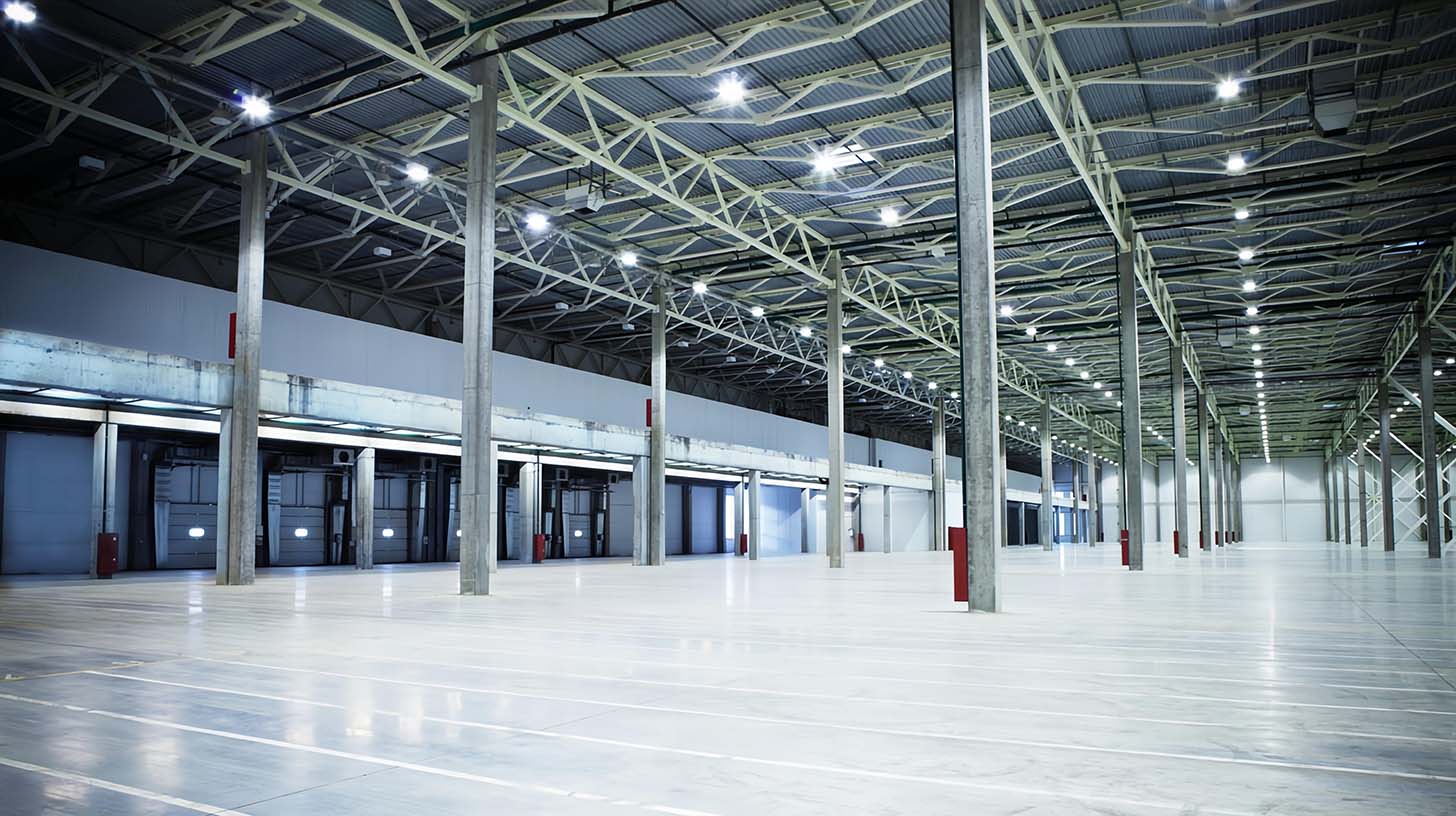
Understanding High Bay Emergency Lighting: An Overview
If you’ve ever ventured into a warehouse, factory, or large retail store, chances are you’ve seen high bay emergency lighting in action. Designed for areas that have high ceilings ranging from 20 feet to approximately 45 feet, this specific type of lighting plays a crucial role in illuminating vast spaces efficiently and effectively.
High bay emergency lighting, as the name suggests, takes the functionality of ordinary high bay lighting and ups the ante by providing much-needed light during emergency situations. This would be invaluable during power outages or when normal lighting fails for whatever reason.
Emergency lights are often seen in the form of LED lamps, primarily known for their longer lifespan, increased resilience to frequent switching, and luminous efficacy. LED lights have been at the forefront of the LED light revolution, providing a significant upgrade from High-Intensity Discharge lamps, halogen lamps, and compact fluorescent lamps. In the realm of high bay lighting, they are truly a game-changer.
These lighting systems are designed with safety and security at the forefront. During an event like a fire or power outage, high bay emergency lighting provides essential visibility aiding in the safe evacuation of buildings. In high-risk areas such as factories or warehouses, they help with navigation, enabling people to locate emergency exits and safety equipment quickly.
With a focus on energy efficiency, modern high bay emergency lighting systems often feature elements like sensors and timers. These components contribute to energy savings by ensuring the lights only activate when necessary, reducing electricity consumption.
Overall, if you have a large, tall space that needs strong, dependable lighting – especially in a crisis – high bay emergency lighting is a worthy investment. Remember, good lighting is not just about visibility; it’s also about safety, energy efficiency, and even peace of mind.

Importance and Applications of High Bay Emergency Lighting
Firstly, let’s understand what sets High Bay Emergency Lighting apart. These are lighting systems designed primarily for high ceiling environments — usually 20 feet or even higher. They’re typically seen in facilities such as warehouses, gymnasiums, hangars, and other commercial or industrial spaces. But why do these places need such specific lighting setups?
High bay lights provide a high level of brightness that is uniformly distributed across large spaces. This consistent and bright illumination is vital for operational safety and productivity in work environments like large stores, factories, and sports facilities. Therefore, the right application of high bay lights can truly improve the efficiency and safety of a workplace.
No one can underestimate the importance of emergency lighting, especially in these zones. LED High Bay emergency lights serve as an essential lifeline if there’s a sudden power outage, facilitating safe evacuation or immediate resumption of work.
Their applications go beyond indoor environments. Believe it or not, they’re incredibly useful outdoors too — think sports arenas and large parking lots. They light up huge areas efficiently and brightly, adding to safety and visibility. This can make a significant difference in reducing accidents and crime in such places.
In conclusion, High Bay Emergency Lighting is more than a legal requirement. It represents a powerful and cost-effective solution to support productivity, safety, and security in various high-volume, well-trafficked commercial and industrial environments.
Legal and Safety Requirements for Emergency Lighting
In the world of safety and compliance, emergency lighting can’t be overlooked. This is especially true for high bay emergency lights mounted in expansive, high-ceiling areas like warehouses, factories, or sports arenas. But what are the legal and safety requirements for this kind of lighting? Let’s dive in.
A matter of law and safety
From a legal perspective, numerous guidelines outline the minimum requirements for emergency lighting. One of the most important international safety standards organizations is the International Electrotechnical Commission (IEC), the standard IEC 60598-2-22 offers comprehensive guidelines on Luminaires for emergency lighting like high bay emergency lights.
In the United States, similar standards are established and maintained by the American National Standards Institute (ANSI) and the Underwriters Laboratories(UL 924). The operations of these organizations ensure that products are safe to use and that they fulfill their intended purposes without posing undue risks to users.
Best practices for high bay emergency lighting
High bay emergency lighting, due to its critical role in ensuring safety during emergencies, is subject to additional regulations and best practices. These lights should ideally be sustained by a reliable battery backup system, enabling them to maintain operation even during complete power failures.
It’s also imperative that these lights offer a minimum illumination of one foot-candle, spreading uniformly across the entire area. This guarantees a certain level of visibility in case of an emergency, allowing occupants to navigate safely.
Comply with local codes and standards
Local building and construction codes often have their own stipulations regarding emergency lighting. Make sure you’re up to speed on your local laws to avoid penalties, fines, or worse – an inadequately lit area during an emergency!
Remember, safety always comes first. A lack of proper emergency lighting can lead to serious injuries or loss of life in the unfortunate event of a disaster. So, always prioritize legal compliance and safety. Reach out to us if you need any assistance on efficient and compliant lighting solutions.
Types of High Bay Emergency Lighting
Round(UFO) LED Emergency High Bay Lights: LED emergency high bay lights come in various types to suit different applications and settings. Among them are Round LED emergency High Bays, also known as UFO high bays. These fixtures are renowned for their ease of installation and emit a circular light beam, typically with a wide angle of around 110 degrees. This ensures crisp and even illumination across the area beneath them. Round LED high bay light fixtures are commonly found in factories, warehouses, grocery stores, and airport hangars, offering a lifespan of over 50,000 maintenance-free hours of operation.

UFO LED High Bay Emergency Lights
Linear LED Emergency High Bay lights: Linear LED emergency high bay lights are another popular option, often seen in environments like grocery stores, warehouses, and other settings with shelving units. Featuring a rectangular shape with varying widths and lengths to suit different applications, these fixtures can be mounted directly to the ceiling or suspended from cables or chains. Many linear LED emergency high bay lights boast a high Color Rendering Index (CRI), ensuring excellent visibility and eliminating dark spots, particularly beneficial in warehouses to enhance safety and reduce the risk of accidents.

Linear LED High Bay Emergency Lights
Best Practices for Implementing High Bay Emergency Lighting
When it comes to implementing high bay emergency lighting in your business or industrial setting, there are several best practices to consider. Doing so will not only ensure the safety and security of your building but will also optimize energy use and maintenance in the long term.
1. Understand your Space
Before rushing to install high bay emergency lighting, it’s important to understand the purpose and specific requirements of your space. Facilities such as warehouses, factories, sports arenas, or any other venues with ceiling heights above 20 feet often use high bay lighting. Discovering the right style of lighting i.e., LED High Bay Light, based on the features of your facility can lead to effective and efficient lighting.
2. Opt for High-Quality Lighting Systems
When it comes to emergency lighting, better to opt for quality over quantity. Emergency lighting is a critical safety feature and it is crucial to install reliable systems that you can trust during an emergency. Consider investing in recognized names in lighting. Also, look for compliance with international standards such as those set by the IEC or UL.
3. Regular Maintenance
Regular maintenance plays a pivotal role in ensuring the longevity and performance of your lighting system. Inspect on a regular basis to check for any faults or inefficiencies that may cause inefficiencies and costs in the long run.
4. Consider Energy-Efficient Options
Opt for LED lighting for your high bay emergency lighting – they’re more energy-efficient, and offer a longer lifespan and better light output compared to traditional lighting systems such as compact fluorescent lamps or halogen lamps.
Implementing high bay emergency lighting following these best practices can give you peace of mind knowing you’ve maximised both the functionality and safety of your space.

Energy Efficiency and Cost Implications of High Bay Emergency Lighting
Given the critical role that high bay emergency lighting plays in industrial and commercial settings, it’s important to consider their energy consumption and cost implications. If you’re looking for ways to bring down your energy bills while keeping safety standards high, LED lighting may be the solution.
The Efficiency of LED High Bay Lights
LED light fixtures stand out for their energy efficiency and are quite revolutionary in the world of lighting. This LED light revolution has been driven by the significant advances in luminous efficacy that LED technology offers.
Unlike traditional light sources such as High-Intensity Discharge, compact fluorescent lamps, and halogen lamps that waste large amounts of energy as heat, LEDs use electricity more efficiently to provide light. This high efficiency can mean substantial energy savings over time.
Cost Implications
While the upfront cost for LED high bay lights might be higher compared to traditional lighting options, the return on investment can bring you remarkable savings in the long run. This is due to factors such as lower energy bills, longer lifespan hence reducing replacement costs, fewer maintenance requirements, and the potential eligibility for energy-efficiency rebates.
Your business may end up saving a lot of money, making LED lights a cost-effective choice for high bay emergency lighting.
Choosing LED High Bay Emergency Lighting
When choosing LED high bay emergency lights, consider the luminous efficiency. You’ll want to look for fixtures that have high lumens per watt, indicating higher efficiency. You should also consider the quality of light produced, for instance, the Color Rendering Index (CRI) and color temperature which can impact visibility in the area the light covers.
For advice on LED High Bay Emergency lighting, contact us for professional guidance. We’d be delighted to help find a solution that saves you energy and cuts costs while also meeting your specific lighting needs.
Conclusion
In conclusion, effective high bay emergency lighting is not just a convenience, but an essential safety requirement. This guide provides insights into choosing suitable lighting systems that can ensure both safety and compliance. Making informed choices can lead to safer and more productive work environments. Remember, when it comes to high bay lighting, what works best for you may not work best for another facility. Therefore, it is crucial to understand the unique requirements of your space. For more questions or custom lighting solutions, feel free to Reach out to us. Safe and efficient lighting is a shining hallmark of a well-organized facility!
Get an Instant Quote Now
Let us help you get started with our superior LED lighting products.
Our LED Lighting experts can help to solve your issues.
Before sending your message, please note:
Your message goes to Logos Lighting and it may take time to reply to you.
Please complete all fields unless otherwise indicated. This will help us deal with your inquiry more efficiently. Alternatively, you can contact us directly via email: info@logosled.com.



